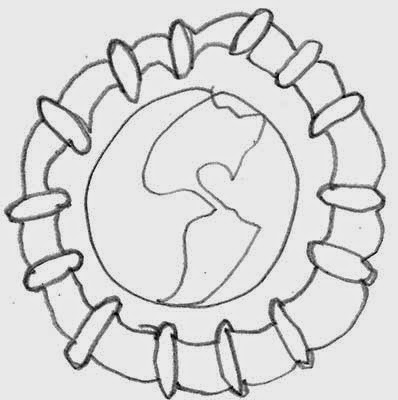
I am guessing that this 1880 quiltmaker suffered a Victorian ailment which kept her bedridden, improved her vision and fine motor skills, and extended her lifespan.
When pieced accurately, hexagon quilts are a miracle; when pieced badly, which is easier, they're a ripply mess. Both are incredibly time-consuming. That's why unfinished hexagon tops and pieces - especially the wonky ones - are relatively cheap and abundant in flea markets and antique shops.
When I first became a quilter, and fell madly in love with vintage quilts, I went through an inevitable phase of collecting hexagonal tops and pieces, Here's one of my purchases:

The purchase is followed by inevitable wondering what to do with it, followed by inevitable realization of how enormous the task is, followed by inevitable stuffing them into a closet until I'm dead, which will inevitably be followed by my children giving them away so they end up in another flea market where another dewy-eyed young quiltmaker will fall in love with them and bring them home.
But wait! There is finally a book that can help interrupt the cycle of hexagonal heartbreak!
Mary Kerr, award-winning quilter and certified appraiser, had a similar appreciation of unfinished hexagon blocks and tops, but instead of merely hoarding them, she made unexpected quilts from them.
Her new book - I asked for a review copy - is "Recycled Hexie Quilts," from Schiffer Publishing, and it contains more than 100 photos of very wonderful quilts made from vintage hexagons, most of which break stereotypes and rules.
Kerr explains that hexagons have been in pieced quilts for at least 300 years. In the 20th century, hexagon piecing designs became known as Grandmother's Flower Garden.
The book shows some antique eyepoppers - like the first quilt at top of this post - but most of the photographs are of quilts Kerr made from old pieces and tops. She combines new fabrics with old, cuts off hexagons at 90 degree angles (!), and places them in unlikely locations, like borders, sashing, and setting squares. Most do not require the kind of time and skill needed to complete the top quilt on this page.
Here's "Mosaic Star," which has a Modern feeling, and requires only hundreds instead of tens of thousands of pieces:
And here's one with even fewer pieces, which means an even more Modern feeling - and guess what - it's FUSED to that black background! (Quilt police hair just caught fire!).
There's a whole chapter on fusing, and really, it's the perfect solution to damaged seams.
In the next quilt, "Roses for Opal," Kerr circled floral panels painted by her grandmother Opal, with hexagons from the 1930s. The pink fabric is from the 1920s. "Mixing eras just creates a more interesting piece and a much better story," Kerr says. I think it also cuts the bubble gum sweetness to a degree that's just right.
Note that she refuses to fuss with the corners. We don't need no mitering! Symmetry is for sissies!
If you don't happen to have vintage duck or floral panels lying around, buy a brand spanking new jelly roll instead and make one of these, combining log cabin with hexagons:
Kerr used a Moda Jelly Roll, but if you Google "pastel fabric jelly roll" you'll come up with lots of options.
The next quilt, "Lancaster," is brilliant - a Grandmother's Flower Garden top cut into diamonds, and joined with a sashing, for an effect that's remniscent of a traditional Japanese art motif.
It's a large 1940s hexagon fused asymmetrically onto a vintage tablecloth.
And there's a much, much more in the book. If you have your own stash of vintage hexagons, this is just what you need to inspire yourself to give them new life. Thanks, Mary Kerr, for writing a great and useful book!
PS One more idea: Here's a blog post from a couple of years ago about something I did with orphan blocks, combining them with Terrie Mangat fabric gew-gaws.

(UPDATE: Here's a link to an utterly astonishing hexagon quilt from 1940 with 58,640 pieces.)




















































